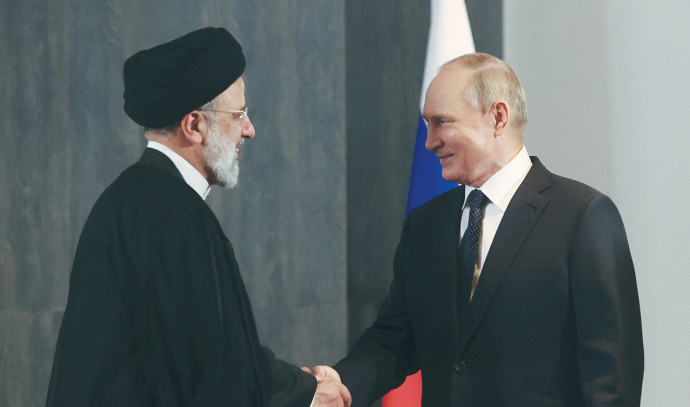|
Getting your Trinity Audio player ready...
|
As Iran formally integrates into the Shanghai Cooperation Organization (SCO), a growing concern is spreading across the Western world, primarily due to the multifaceted implications of Iran’s growing military ties with Russia and China. The issue becomes even more troubling with the scheduled ending of UN restrictions on Iran’s ballistic missile testing and transfers this coming October.
This will grant Iran a freer hand to openly trade arms with Russia and China, and other SCO countries, which results in Iran’s expanding its influence and aggression in the region. The West needs to carefully consider the repercussions of this significant strategic development.
Iran’s admission to the SCO represents a significant foreign policy achievement for the Islamic Republic. This is particularly noteworthy as it is the first time the regime has joined a regional pact since its establishment in 1979.
The Islamic Republic has sought to become a full member of the SCO for many years, and in a 2021 meeting of the organization in Kazakhstan, it was decided that Iran would be admitted as a permanent member, a change that came into effect on July 4th, 2023.
This integration can help Iran break free from its economic and diplomatic isolation. In fact, that Iran has been granted full membership in the SCO suggests that other member countries are also open to engaging with it. The Islamic Republic is banking on the SCO to improve its sanctions-stricken economy.
The regime’s goal here is to utilize the SCO as a tool to replace the US dollar in global trade to bypass unilateral US sanctions. To this end, the Iranian regime has proposed the creation of a new currency for transactions with China, Russia, and other SCO members.
Although such a plan isn’t likely to end the dollar’s reign any time soon, however, if it materializes it will facilitate trade between Iran and other SCO nations, eliminating the need for US dollars and accessing the US-controlled global financial system.
What raises more concern is the intention of the Islamic Republic – alongside Russia and China – to leverage the SCO as a platform to diminish Western military influence and to challenge the US’s and Europe’s military power. The regime-affiliated IRNA news agency has categorically identified this aspect as a significant element of SCO membership, noting that “four decades of continuous efforts by the West, the United States, and the Zionist regime to isolate Iran have been nullified by Tehran’s membership in [SCO] one of the most important international organizations.”
In light of this, it is noteworthy to mention the existing military alliances between Iran and some of the SCO members. The level of military cooperation between Iran and Russia is already remarkable.
Russia and Iran are already very close
SINCE 2010, the two countries have carried out nine joint military exercises. Both regimes developed a new and unprecedented strategic alliance after Putin’s invasion of Ukraine in February 2022. The Iranian regime has provided hundreds of reconnaissance and Iranian-made Mohajer-6 drones, one of its top airborne combat attack vehicles, and the Shahed-136 kamikaze drone that Russia deployed against civilian targets and critical infrastructure in Ukraine. Iranian military advisers were reportedly deployed on the Ukrainian battlefield to train Russian forces on how to use Iranian drones.
Iran also shipped artillery and tank rounds to Russia and supplied the Russian army with ammunition and body armor. Iran has also agreed to help Russia manufacture drones. It is expected that the Islamic Republic will transfer short-range ballistic missiles, including the Fateh-110 and Zolfaghar, to Russia once the UN prohibitions on ballistic missile testing and transfers terminate this October.
In exchange, Russia is going to provide the Islamic Republic with advanced fighter jets, attack helicopters, radars, combat trainer aircraft, electronics, and air defense systems. Iranian pilots have already started training in Russia on the Sukhoi Su-35, since the spring of 2022. The Su-35 would significantly strengthen Iran’s air force relative to its regional neighbors.
The level of military cooperation between Iran and China is also disturbing. On March 2021, Iran and China signed a 25-year cooperation agreement that vowed to strengthen military ties through joint training and exercises, joint research, and weapons development. Along with Russia, China and Iran conducted joint naval drills in the Indian Ocean and agreed to expand cooperation on maritime security, create a maritime community with a common future, and improve strategic defense cooperation.
The close military collaboration between the countries has major implications for the US domination of the Gulf and large stretches of the Indian Ocean. China and Iran have been working on a large arms deal timed to coincide with the ending of the UN Security Council arms restrictions on Iran.
Besides, Chinese companies and individuals are assisting Iran with parts and dual-use materials. Chinese companies assisted Iran in a procurement part that is used to develop ICBM nosecones and rocket nozzles. Companies in Hong Kong also assisted the regime with the illicit procurement of dual-use goods, accelerometers, and gyroscopes destined for its defense-industrial base. In April 2023, it was reported that the regime was seeking large quantities of ammonium perchlorate that is used as an oxidizer in solid-rocket fuel from China, a blatant violation of US sanctions.
Membership in the SCO will also empower the Iranian regime to broaden its military cooperation with India. The two countries, already engaged in a “comprehensive partnership,” are striving to extend their bilateral military collaboration into new areas, which include joint naval exercises and arms trade.
The SCO’s geopolitical significance is growing in the wake of Russia’s invasion of Ukraine and the prominent positions of Russia and China within the organization. With the new addition of Iran, which seeks to leverage the SCO as a counterforce against the United States and Europe, this organization emerges as a potential threat to the West.
To counter the Islamic Republic’s pursuit of its objectives through the SCO, it is crucial for the US and EU to maintain economic sanctions on the regime. Furthermore, to prevent it from becoming a formidable military force against the West, the United States should reimpose an arms embargo on Iran, placing emphasis, especially on the restriction of the regime’s drones and missile programs. This can be achieved by invoking the Snapback mechanism at the UN Security Council, which would permit the reimposition of these restrictions.
The writer is a senior fellow at the Philos Project.



